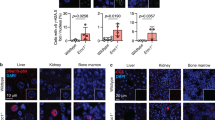Abstract
We previously reported the identification of a novel zinc-finger gene, designated ZSG, fused to Ewing sarcoma gene (EWS) by a submicroscopic paracentric inversion of 22q12 in a small round cell sarcoma presenting a translocation t(1;22)(p34;q12). We report here the molecular cloning and characterization of the breakpoint in 1p34, which encompasses the gene coding for mitochondrial Hinge protein ubiquinol-cytochrome C reductase hinge gene (UQCRH). All the three breakpoints, two on 22q12 and one in 1p34, interrupt different genes: EWS, ZSG and UQCRH. We determined the genomic structure of UQCRH, characterized its splicing variants and identified a transcribed processed pseudogene. The analysis of UQCRH expression in normal tissues and cancer cell lines revealed absent expression of UQCRH in two ovarian and one breast cancer cell lines and reduced expression in a further breast carcinoma cell line. CpG island methylation upstream exon 1 was detected in all the three cell lines with absent expression. Moreover, treatment with demethylating agent 5-azacytidine restored UQCRH expression in OAW42 ovarian cancer cells. These data provide preliminary evidence of the inactivation of UQCRH gene in cancer either by structural rearrangements or epigenetic mechanisms.
This is a preview of subscription content, access via your institution
Access options
Subscribe to this journal
Receive 50 print issues and online access
$259.00 per year
only $5.18 per issue
Buy this article
- Purchase on Springer Link
- Instant access to full article PDF
Prices may be subject to local taxes which are calculated during checkout





Similar content being viewed by others
References
Arvand A and Denny CT . (2001). Oncogene, 20, 5747–5754.
Baysal BE, Ferrell RE, Willett-Brozick JE, Lawrence EC, Myssiorek D, Bosch A, van der MA, Taschner PE, Rubinstein WS, Myers EN, Richard III CW, Cornelisse CJ, Devilee P and Devlin B . (2000). Science, 287, 848–851.
Crivellone MD, Wu MA and Tzagoloff A . (1988). J. Biol. Chem., 263, 14323–14333.
Iwata S, Lee JW, Okada K, Lee JK, Iwata M, Rasmussen B, Link TA, Ramaswamy S and Jap BK . (1998). Science, 281, 64–71.
Jones DH and Winistorfer SC . (1997). Biotechniques, 23, 132–138.
Kim CH and King TE . (1983). J. Biol. Chem., 258, 13543–13551.
Kim CH, Yencha AJ, Bunker G, Zhang G, Chance B and King TE . (1989). Biochemistry, 28, 1439–1441.
Kovar H . (1998). Curr. Opin. Oncol., 10, 334–342.
Liu AY and Bradner RC . (1993). Cancer Res., 53, 2460–2465.
Mastrangelo T, Modena P, Tornielli S, Bullrich F, Testi MA, Mezzelani A, Radice P, Azzarelli A, Pilotti S, Croce CM, Pierotti MA and Sozzi G . (2000). Oncogene, 19, 3799–3804.
Megonigal MD, Rappaport EF, Jones DH, Williams TM, Lovett BD, Kelly KM, Lerou PH, Moulton T, Budarf ML and Felix CA . (1998). Proc. Natl. Acad. Sci. USA, 95, 6413–6418.
Mukai K, Miyazaki T, Wakabayashi S, Kuramitsu S and Matsubara H . (1985). J. Biochem. (Tokyo), 98, 1417–1425.
Ohta S, Goto K, Arai H and Kagawa Y . (1987). FEBS Lett., 226, 171–175.
Okazaki M, Ishibashi Y, Asoh S and Ohta S . (1998). Biochem. Biophys. Res. Commun., 243, 131–136.
Rustin P . (2002). Nat. Genet., 30, 352–353.
Santiard-Baron D, Gosset P, Nicole A, Sinet PM, Christen Y and Ceballos-Picot I . (1999). Exp. Neurol., 158, 206–213.
Scherf U, Ross DT, Waltham M, Smith LH, Lee JK, Tanabe L, Kohn KW, Reinhold WC, Myers TG, Andrews DT, Scudiero DA, Eisen MB, Sausville EA, Pommier Y, Botstein D, Brown PO and Weinstein JN . (2000). Nat. Genet., 24, 236–244.
Schoppink PJ, Hemrika W and Berden JA . (1989). Biochim. Biophys. Acta, 974, 192–201.
Schoppink PJ, Hemrika W, Reynen JM, Grivell LA and Berden JA . (1988). Eur: J. Biochem., 173, 115–122.
Tomlinson IP, Alam NA, Rowan AJ, Barclay E, Jaeger EE, Kelsell D, Leigh I, Gorman P, Lamlum H, Rahman S, Roylance RR, Olpin S, Bevan S, Barker K, Hearle N, Houlston RS, Kiuru M, Lehtonen R, Karhu A, Vilkki S, Laiho P, Eklund C, Vierimaa O, Aittomaki K, Hietala M, Sistonen P, Paetau A, Salovaara R, Herva R, Launonen V and Aaltonen LA . (2002). Nat. Genet., 30, 406–410.
Acknowledgements
We thank Dr Frank Speleman for kindly providing us with the neuroblastoma cell lines, Dr Manuela Campiglio for breast cancer cell lines, and Dr Mariano Rocchi for free distribution of FISH probes (http://www.biologia.uniba.it/rmc). We are grateful to Mrs Silvia Grassi for the editing of the manuscript. This work was partially supported by the Associazione Italiana per la Ricerca sul Cancro (AIRC) and by Ministero della salute.
Author information
Authors and Affiliations
Corresponding author
Rights and permissions
About this article
Cite this article
Modena, P., Testi, M., Facchinetti, F. et al. UQCRH gene encoding mitochondrial Hinge protein is interrupted by a translocation in a soft-tissue sarcoma and epigenetically inactivated in some cancer cell lines. Oncogene 22, 4586–4593 (2003). https://doi.org/10.1038/sj.onc.1206472
Received:
Revised:
Accepted:
Published:
Issue Date:
DOI: https://doi.org/10.1038/sj.onc.1206472
Keywords
This article is cited by
-
Knockout of the Complex III subunit Uqcrh causes bioenergetic impairment and cardiac contractile dysfunction
Mammalian Genome (2023)
-
UQCRH downregulation promotes Warburg effect in renal cell carcinoma cells
Scientific Reports (2020)
-
Tumour and patient factors in renal cell carcinoma—towards personalized therapy
Nature Reviews Urology (2015)
-
Comprehensive molecular characterization of clear cell renal cell carcinoma
Nature (2013)
-
Molecular detection and targeting of EWSR1 fusion transcripts in soft tissue tumors
Medical Oncology (2013)



